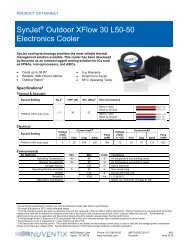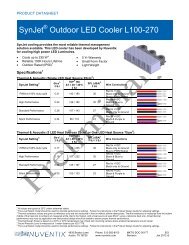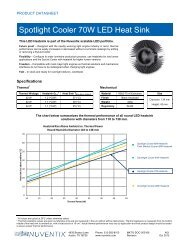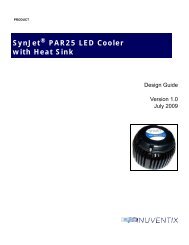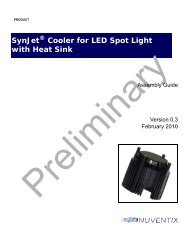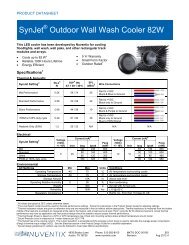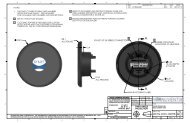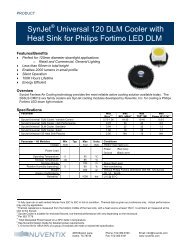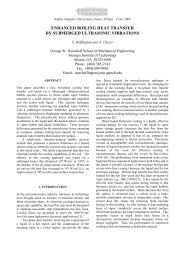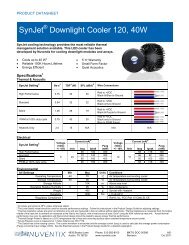LED Cooling in Harsh Environments with Synthetic Jet ... - Nuventix
LED Cooling in Harsh Environments with Synthetic Jet ... - Nuventix
LED Cooling in Harsh Environments with Synthetic Jet ... - Nuventix
Create successful ePaper yourself
Turn your PDF publications into a flip-book with our unique Google optimized e-Paper software.
www.led-professional.com<br />
ISSN 1993-890X<br />
Review<br />
The lead<strong>in</strong>g worldwide authority for <strong>LED</strong> light<strong>in</strong>g technology <strong>in</strong>formation May/June 2011 | Issue 25<br />
LpR<br />
<strong>LED</strong> <strong>Cool<strong>in</strong>g</strong> <strong>in</strong><br />
<strong>Harsh</strong> <strong>Environments</strong><br />
<strong>with</strong> <strong>Synthetic</strong> <strong>Jet</strong><br />
Technology
THERMAL<br />
ACTIVE COOLING RELIABILITY<br />
2<br />
<strong>LED</strong> <strong>Cool<strong>in</strong>g</strong> <strong>in</strong> <strong>Harsh</strong><br />
<strong>Environments</strong> <strong>with</strong> <strong>Synthetic</strong><br />
<strong>Jet</strong> Technology<br />
Dr. Markus Schwickert, Director of Reliability and Brandon Noska, Application Eng<strong>in</strong>eer<strong>in</strong>g Manager at<br />
<strong>Nuventix</strong> discuss different reliability issues of active cool<strong>in</strong>g. Test procedures and results to prove<br />
longevity of sophisticated active cool<strong>in</strong>g systems are presented.<br />
Light<strong>in</strong>g is rapidly transition<strong>in</strong>g<br />
from traditional lamp sources<br />
such as high-pressure sodium,<br />
metal halide, mercury vapor, and<br />
fluorescent to high brightness<br />
light-emitt<strong>in</strong>g diodes (HB<br />
<strong>LED</strong>s). In fact, illum<strong>in</strong>ation was<br />
the second fastest grow<strong>in</strong>g<br />
application for HB <strong>LED</strong>s <strong>in</strong> 2009,<br />
<strong>with</strong> a growth rate of 28.6% over<br />
2008, and this trend shows no<br />
signs of slow<strong>in</strong>g. Architectural<br />
light<strong>in</strong>g, comb<strong>in</strong>ed <strong>with</strong><br />
commercial/<strong>in</strong>dustrial sectors<br />
and the outdoor sector, account<br />
for 54.3% of the illum<strong>in</strong>ation<br />
market [1].<br />
Along <strong>with</strong> general illum<strong>in</strong>ation<br />
products, <strong>LED</strong> outdoor light<strong>in</strong>g needs<br />
proper thermal management <strong>in</strong> order<br />
to utilize the many advantages of <strong>LED</strong>s<br />
such as a long L70 lifetime, <strong>in</strong>stant on,<br />
better optical control, and, most<br />
importantly, low ma<strong>in</strong>tenance and<br />
reduced energy usage. Outdoor<br />
products cover a wide range of<br />
<strong>in</strong>stallations <strong>in</strong>clud<strong>in</strong>g wall wash<strong>in</strong>g,<br />
park<strong>in</strong>g lot, area light<strong>in</strong>g, roadway<br />
light<strong>in</strong>g, and garage light<strong>in</strong>g, to name a<br />
few. Some of these form factors have<br />
enough surface area to allow for<br />
effective natural convection cool<strong>in</strong>g,<br />
but pose other issues such as weight<br />
and large surfaces which are not good<br />
for shipp<strong>in</strong>g, handl<strong>in</strong>g, <strong>in</strong>stallation, and<br />
w<strong>in</strong>d load<strong>in</strong>g. Other form factors such<br />
as retrofit lamps are bound by exist<strong>in</strong>g<br />
<strong>in</strong>frastructure and need to rema<strong>in</strong><br />
compact <strong>in</strong> order to fit <strong>in</strong>to exist<strong>in</strong>g<br />
sockets. In all cases, if a reliable<br />
technology for forced convection<br />
cool<strong>in</strong>g was available, designers would<br />
have more options to provide the<br />
proper lumen outputs while hav<strong>in</strong>g<br />
small, lightweight designs.<br />
Industrial and outdoor applications<br />
pose other challenges <strong>in</strong> addition to<br />
the thermal management<br />
requirements. Components need to be<br />
rugged <strong>in</strong> order to operate properly<br />
and to survive the elements. Although<br />
traditional air movers such as axial fans<br />
could provide an adequate forced<br />
convection thermal solution, this article<br />
will focus on synthetic jet cool<strong>in</strong>g<br />
technology, which is an alternative air<br />
mov<strong>in</strong>g technology for forced<br />
convection cool<strong>in</strong>g. This article looks<br />
at synthetic jet technology as a rugged<br />
and reliable forced convection cool<strong>in</strong>g<br />
solution that could be used <strong>in</strong> harsh<br />
environments to ensure effective<br />
thermal management solutions.<br />
<strong>Synthetic</strong> <strong>Jet</strong>s<br />
Although synthetic jets have been<br />
known and researched for many years,<br />
synthetic jet products are relatively<br />
new to the market. <strong>Synthetic</strong> jets are<br />
formed by creat<strong>in</strong>g a periodic suction<br />
and ejection of fluids through an orifice<br />
generated by an oscillat<strong>in</strong>g diaphragm<br />
<strong>in</strong> a cavity surround<strong>in</strong>g the diaphragm.<br />
The jets are “zero-mass-flux,” thus<br />
there is no need for duct<strong>in</strong>g or pip<strong>in</strong>g<br />
<strong>in</strong> the medium for cool<strong>in</strong>g. When these<br />
jets are directed at heat s<strong>in</strong>k surfaces,<br />
they remove the heat much more<br />
efficiently than natural convection<br />
[2,3,4].<br />
Figure 1: <strong>Synthetic</strong> jet eng<strong>in</strong>e <strong>with</strong><br />
oscillat<strong>in</strong>g diaphragm<br />
<strong>Synthetic</strong> jets can be generated <strong>in</strong><br />
many ways, but one mechanism is the<br />
use of electromagnet actuators which<br />
create the driv<strong>in</strong>g force for oscillat<strong>in</strong>g<br />
the membrane. As the membrane<br />
oscillates <strong>with</strong><strong>in</strong> the cavity, synthetic<br />
jets are created at the nozzles that are<br />
around the cavity. There are many<br />
advantages to us<strong>in</strong>g electromagnetic<br />
actuators <strong>in</strong>clud<strong>in</strong>g no mov<strong>in</strong>g parts <strong>in</strong><br />
friction, no lubricants, and no bear<strong>in</strong>gs<br />
to wear out. These <strong>in</strong>herent design<br />
differences between synthetic jets and<br />
traditional air movers such as fans and<br />
blowers are what differentiate these<br />
products <strong>in</strong> terms of ruggedness and<br />
Issue 25 2011<br />
© 2011 LUGER RESEARCH e.U.
THERMAL<br />
ACTIVE COOLING RELIABILITY<br />
3<br />
Figure 2 / Table 1:<br />
Natural<br />
convection versus<br />
forced convection.<br />
The table shows<br />
comparison<br />
data for natural<br />
convection versus<br />
forced convection<br />
Metric<br />
lifetime. The ma<strong>in</strong> failure mode of fans<br />
and blowers is lubricant breakdown.<br />
This does not exist <strong>in</strong> synthetic jet<br />
products [5,6].<br />
Benefits of Forced <strong>Cool<strong>in</strong>g</strong><br />
<strong>Synthetic</strong> jet cool<strong>in</strong>g allows for smaller<br />
form factors, lower operat<strong>in</strong>g<br />
temperatures, and dynamic airflow<br />
control for effective temperature<br />
control of the <strong>LED</strong> heat s<strong>in</strong>k.<br />
<strong>Synthetic</strong> jets have been shown to<br />
have higher Nusselt numbers, hence<br />
higher effective heat transfer, over<br />
conventional ducted flows by a factor<br />
of six or greater at the same channel<br />
Reynolds number. In addition, when<br />
compar<strong>in</strong>g the thermal resistance of a<br />
heat s<strong>in</strong>k (θ s-a<br />
) cooled by synthetic jets<br />
or ducted flow at the same volumetric<br />
flow rate, synthetic jets have<br />
demonstrated as much as a 40%<br />
improvement <strong>in</strong> thermal performance.<br />
When compared to natural convection,<br />
synthetic jets have demonstrated<br />
300% thermal improvement <strong>with</strong> the<br />
same form factor heat s<strong>in</strong>k [7].<br />
Natural<br />
Convection<br />
Forced<br />
Convection<br />
Improvement<br />
Form Factor Volume, cm 3 5640 1400 75%<br />
Weight (kg) 3.0 1.4 53%<br />
Thermal performance θsa, C/W 0.25 0.2 20%<br />
The forced convection cool<strong>in</strong> provides<br />
a 20% reduction <strong>in</strong> thermal resistance<br />
resistance (qs-a), <strong>with</strong> a 75% reduction<br />
<strong>in</strong> volume and 53% reduction <strong>in</strong><br />
weight.<br />
The Evluma 40 W <strong>LED</strong> replacement<br />
lamp / lum<strong>in</strong>aire for outdoor NEMA<br />
Type 5 fixtures is an example of a<br />
synthetic-jet cooled product available<br />
on the market today. This product<br />
replaces exist<strong>in</strong>g mogul base<br />
50-175 W mercury vapor or 70-150 W<br />
high pressure sodium lamps. Evluma’s<br />
40 W <strong>LED</strong> lamp is an example of a<br />
product that utilizes forced cool<strong>in</strong>g to<br />
dissipate 40 W, while keep<strong>in</strong>g the form<br />
factor small for retrofit applications.<br />
Figure 3: Evluma’s 40W <strong>LED</strong> Clearlight<br />
Although the use of forced cool<strong>in</strong>g has<br />
many benefits as listed above, there<br />
are several elements that need to be<br />
considered for outdoor light<strong>in</strong>g. Typical<br />
requirements <strong>in</strong>clude IP 55 for<br />
electronics and other components,<br />
IP 67 for optical compartments, ability<br />
to <strong>with</strong>stand wash downs, to be<br />
cleaned, large temperature extremes,<br />
vibration due to w<strong>in</strong>d load<strong>in</strong>g and<br />
roadway vibrations. An effective<br />
outdoor <strong>LED</strong> light requires<br />
components that can <strong>with</strong>stand such<br />
elements. <strong>Synthetic</strong> jets offer a rugged<br />
and reliable solution. <strong>Synthetic</strong> jets are<br />
typically tested aga<strong>in</strong>st high temp/high<br />
humidity, shock/vibration, dust, and<br />
power cycl<strong>in</strong>g [8].<br />
The next sections highlight the various<br />
test<strong>in</strong>g that is conducted on synthetic<br />
jet devices and the importance of this<br />
test<strong>in</strong>g:<br />
The higher heat transfer capability at<br />
low flow and significant improvement<br />
over natural convection is due to the<br />
turbulent vortex dom<strong>in</strong>ated jet flow<br />
which enhances the mix<strong>in</strong>g of the<br />
thermal boundary layer and allows for<br />
improved thermal performance. For<br />
example, Figure two compares a<br />
100 W design <strong>with</strong> forced convection<br />
cool<strong>in</strong>g and natural convection cool<strong>in</strong>g.<br />
Figure 4: Annual average temperature map, source Wikipedia.org<br />
© 2011 LUGER RESEARCH e.U.<br />
Issue 25 2011
THERMAL<br />
ACTIVE COOLING RELIABILITY<br />
4<br />
Reliability<br />
The local environment of a cool<strong>in</strong>g<br />
solution <strong>in</strong> an outdoor light fixture<br />
depends very much on the<br />
construction of the enclosure and the<br />
location and orientation of <strong>in</strong>stallation.<br />
Earth atmospheric temperatures<br />
typically range from -40°C to +40°C<br />
and can reach over +55°C <strong>in</strong> extreme<br />
conditions. Variations occur <strong>in</strong> day/<br />
night cycles and throughout the<br />
seasons while the relative humidity (r.h.)<br />
can range from nearly 0 to 100%.<br />
Furthermore, pollution (e.g. acidic<br />
atmospheres, pesticides, clean<strong>in</strong>g<br />
solutions, build<strong>in</strong>g materials), ozone,<br />
UV light, and naturally occurr<strong>in</strong>g<br />
substances <strong>in</strong> the atmosphere<br />
(e.g. dust, pollen, <strong>in</strong>sects) will <strong>in</strong>teract<br />
<strong>with</strong> light fixtures and may reach<br />
<strong>in</strong>ternal components such as the<br />
<strong>LED</strong>s, electronics, drivers and cool<strong>in</strong>g<br />
solutions, impact<strong>in</strong>g functionality or<br />
lifetime. Generally, harsh environments<br />
can not only be found outdoors, but <strong>in</strong><br />
some <strong>in</strong>dustrial sett<strong>in</strong>gs or specialty<br />
applications (e.g. aquariums,<br />
commercial kitchens, automotive etc.)<br />
as well.<br />
Even rat<strong>in</strong>gs for <strong>in</strong>gress protection (IP)<br />
will not reveal how the lifetime of a<br />
product is affected by harsh<br />
environments, but rather testify to its<br />
safety and ability to function under<br />
those conditions <strong>in</strong> the short term.<br />
Here we focus on the cool<strong>in</strong>g solution<br />
of a lum<strong>in</strong>aire which must exceed the<br />
lifetime of the <strong>LED</strong>s by far so that it<br />
contributes positively to the overall<br />
lifetime of the lum<strong>in</strong>aire via extension of<br />
the <strong>LED</strong> lifetime, and does not limit it<br />
further [9].<br />
Given the unique requirements for all<br />
different products and environments,<br />
there is no standard or set regiment of<br />
test<strong>in</strong>g that can guarantee outdoor<br />
suitability across the board. Moreover,<br />
a robust product <strong>with</strong> reliability<br />
designed <strong>in</strong> must be measured up to<br />
the <strong>in</strong>tended usage environments from<br />
the early design phase through the<br />
production release. A thorough review<br />
and qualification of the<br />
subcomponents, materials and even<br />
processes used <strong>in</strong> manufactur<strong>in</strong>g is a<br />
must when design<strong>in</strong>g for reliability.<br />
As a result, the latest Syn<strong>Jet</strong> family of<br />
products, synthetic jets<br />
commercialized by <strong>Nuventix</strong>, has<br />
elim<strong>in</strong>ated all structural adhesive jo<strong>in</strong>ts,<br />
and all materials and components<br />
must pass a 60 hour autoclave test<br />
(Highly Accelerated Stress Test, HAST)<br />
at 123°C, >95% r.h. and 2<br />
atmospheres pressure.<br />
With <strong>in</strong>put from numerous customers<br />
who <strong>in</strong>quired about outdoor usage,<br />
<strong>Nuventix</strong> has developed a platformbased<br />
comprehensive qualification test<br />
matrix for synthetic jet products that<br />
helps <strong>in</strong> predict<strong>in</strong>g long-life<br />
performance under all realistic<br />
conditions, some of which are<br />
discussed below.<br />
Freez<strong>in</strong>g Ra<strong>in</strong> Cycle Test<br />
This cyclic test is designed to address<br />
the repeated wett<strong>in</strong>g and freez<strong>in</strong>g of a<br />
product. In an environmental test<br />
chamber the test starts at standard<br />
ambient temperature (+25°C) <strong>with</strong><br />
>95% r.h. followed by a sudden drop<br />
to ‐10°C to condense water on the unit<br />
and freeze it. After 10 m<strong>in</strong>utes of<br />
freez<strong>in</strong>g the unit is powered on for five<br />
m<strong>in</strong>utes and then operation is<br />
validated. This is repeated a m<strong>in</strong>imum<br />
of 100 times.<br />
Thermal Cycl<strong>in</strong>g<br />
Thermal cycl<strong>in</strong>g, besides expos<strong>in</strong>g the<br />
materials to a wide temperature range,<br />
addresses designs <strong>with</strong> mismatched<br />
coefficients of thermal expansion (CTE)<br />
and stresses jo<strong>in</strong>ts and material<br />
properties. By go<strong>in</strong>g 200 times or<br />
more between -40°C and +105°C,<br />
soak<strong>in</strong>g for an hour at each<br />
temperature and ramp rates of 5°C/<br />
m<strong>in</strong>ute <strong>with</strong> no failures allowed, this<br />
test adds to the confidence needed for<br />
a robust product <strong>in</strong> harsh conditions.<br />
Humidity<br />
The effects of high temperature and<br />
high humidity can be surpris<strong>in</strong>g. Two<br />
major areas are affected: plastic<br />
material degradation and metallic<br />
corrosion. All synthetic jet types are<br />
tested for a m<strong>in</strong>imum of 2,000 hours at<br />
85°C and 85% r.h. <strong>with</strong> no failures<br />
allowed.<br />
Cyclic Condens<strong>in</strong>g Humidity<br />
Very hot and humid conditions are not<br />
as realistic as cyclic humidity<br />
conditions <strong>with</strong> condensation which<br />
can be achieved by cool<strong>in</strong>g a device<br />
and then subject<strong>in</strong>g it to warmer,<br />
humid air (similar to tak<strong>in</strong>g a water<br />
bottle out of a refrigerator which will<br />
typically condense a lot of water from a<br />
sufficiently humid atmosphere). Dur<strong>in</strong>g<br />
the morn<strong>in</strong>g hours <strong>in</strong> most outdoor<br />
environments, depend<strong>in</strong>g on heat<br />
capacity and heat conduction of an<br />
object, condensation will be found on<br />
its surface. Repeat<strong>in</strong>g this process<br />
<strong>with</strong> subsequent dry<strong>in</strong>g 200 or more<br />
times <strong>in</strong> a laboratory environment will<br />
br<strong>in</strong>g out material and design<br />
weaknesses associated <strong>with</strong><br />
condens<strong>in</strong>g humidity.<br />
HALT<br />
Highly Accelerated Life Test<strong>in</strong>g uses a<br />
comb<strong>in</strong>ation step stress method to<br />
determ<strong>in</strong>e the marg<strong>in</strong>s of operation for<br />
a product and highlights weak l<strong>in</strong>ks <strong>in</strong><br />
a design. Stressors <strong>in</strong>clude cold and<br />
hot thermal stress as well as<br />
mechanical vibration stress. Table 2<br />
shows an example of Syn<strong>Jet</strong> limits as<br />
determ<strong>in</strong>ed by HALT.<br />
Qualification Matrix<br />
Table 3 shows a summary of tests that<br />
were done and passed <strong>with</strong> the latest<br />
synthetic jet family of products.<br />
Besides conditions, Table 3 also<br />
<strong>in</strong>dicates the sample size that was<br />
used <strong>in</strong> the test.<br />
Conclusion<br />
Forced convection cool<strong>in</strong>g can offer<br />
smaller and lighter weight designs<br />
while ma<strong>in</strong>ta<strong>in</strong><strong>in</strong>g the proper thermal<br />
management needed to keep HB<br />
<strong>LED</strong>s <strong>with</strong><strong>in</strong> their design parameters.<br />
<strong>Synthetic</strong> jet technology is an airmov<strong>in</strong>g<br />
technology for forced<br />
convection cool<strong>in</strong>g that is <strong>in</strong>herently<br />
reliable and rugged due to a<br />
construction that does not have<br />
mov<strong>in</strong>g parts <strong>in</strong> friction or require<br />
bear<strong>in</strong>gs or lubricants. <strong>Synthetic</strong> jet<br />
products are subjected to a rigorous<br />
qualification program to ensure the<br />
products are robust and can handle a<br />
wide application space.<br />
Issue 25 2011<br />
© 2011 LUGER RESEARCH e.U.
THERMAL<br />
ACTIVE COOLING RELIABILITY<br />
5<br />
Figure 5:<br />
<strong>Synthetic</strong> jet<br />
undergo<strong>in</strong>g<br />
freez<strong>in</strong>g ra<strong>in</strong> cycle<br />
test<br />
F<strong>in</strong>ally, there is no exact test that can<br />
predict performance and reliability<br />
under all environmental conditions for<br />
every conceivable lum<strong>in</strong>aire design.<br />
However, by simulat<strong>in</strong>g worst case<br />
specific environmental conditions that<br />
occur dur<strong>in</strong>g the expected life of an HB<br />
<strong>LED</strong> light and us<strong>in</strong>g accelerated stress<br />
tests for anticipated failure modes one<br />
can ga<strong>in</strong> confidence <strong>in</strong> applications <strong>in</strong><br />
harsh environments.<br />
Table 2:<br />
HALT operat<strong>in</strong>g<br />
and destruct limits<br />
Table 3:<br />
The qualification<br />
matrix shows a<br />
summary of tests<br />
<strong>in</strong>clud<strong>in</strong>g the<br />
sample size<br />
Summary of Operat<strong>in</strong>g and Destruct Limits<br />
Stress Type<br />
Temperature Lower Operat<strong>in</strong>g Limit (LOL)<br />
Temperature Lower Destruct Limit (LDL)<br />
Temperature Upper Operat<strong>in</strong>g Limit (UOL)<br />
Temperature Upper Destruct Limit<br />
Thermal Transitions (°C)<br />
Vibration Operat<strong>in</strong>g Limit (OL)<br />
Vibration Destruct Limit (DL)<br />
Comb<strong>in</strong>ed Operat<strong>in</strong>g Limit (OL)<br />
Comb<strong>in</strong>ed Destruct Limit (DL)<br />
Chamber Setpo<strong>in</strong>t Level<br />
-60°C<br />
< -100°C<br />
+120°C<br />
> +130°C<br />
Greater than +50°C/m<strong>in</strong>ute<br />
45 Grms<br />
45 Grms<br />
60 Grms and 115°C to -60°C<br />
65 Grms and -60°C<br />
Cat. Test Operat<strong>in</strong>g Conditions Samples<br />
Storage<br />
Operational<br />
Mechanical<br />
Environmental<br />
HAST<br />
no<br />
60 hours at 123°C, 96% r.h.,<br />
2 atmospheres<br />
Low Temperature no -40 °C 11<br />
Accelerated Life Test<strong>in</strong>g yes 3,300 hours at 105°C 540<br />
Life Test<strong>in</strong>g at max normal<br />
yes<br />
9,000 hours at 85°C, ongo<strong>in</strong>g<br />
Low Temperature yes -40°C 87<br />
Humidity yes 85°C/85% r.h., 3,250 hours 60<br />
Thermal Cycl<strong>in</strong>g yes -40˚C - +105˚C, 200x 60<br />
S<strong>in</strong>e Sweep<strong>in</strong>g<br />
S<strong>in</strong>e Dwell<strong>in</strong>g<br />
no<br />
no<br />
5-150 Hz, 2G 3 sweeps<br />
per axis<br />
10 m<strong>in</strong> each top of three<br />
peaks, 5 G<br />
Random Vibration yes 2.2 G rms<br />
, 20 m<strong>in</strong>. each axis 18<br />
Shock<br />
no<br />
Six half-s<strong>in</strong>e shocks per<br />
direction, 40 G, 11 ms<br />
Bump Test - 1,000 shocks, 25 G, 10 ms 18<br />
Dust yes 12 hours IEC 60529 (IP5X) 4<br />
Cyclic humidity<br />
Freez<strong>in</strong>g Ra<strong>in</strong> Cycles<br />
yes<br />
yes<br />
200 cycles between +50˚C<br />
/ >95% r.h. and +5˚C / 5%<br />
r.h., such that condensation<br />
occurred<br />
100 cycles between +25˚C /<br />
95% r.h. and –10˚C / u.c.r.h.<br />
3<br />
75<br />
18<br />
18<br />
18<br />
22<br />
21<br />
References:<br />
[1] Strategies Unlimited, “High-<br />
Brightness <strong>LED</strong> Market Review and<br />
Forecast 2010”, pp. 78- 83, June<br />
2010<br />
[2] Lasance, Clemens J. M., Aarts,<br />
Ronald M., “<strong>Synthetic</strong> <strong>Jet</strong> <strong>Cool<strong>in</strong>g</strong><br />
Part I: Overview of Heat Transfer and<br />
Acoustics”, 24th IEEE SEMI-THERM<br />
Symposium, 2008, pp. 20-25, 2008<br />
[3] Mahal<strong>in</strong>gam, R., N. Rumigny, A.<br />
Glezer, "Thermal Management Us<strong>in</strong>g<br />
<strong>Synthetic</strong> <strong>Jet</strong> Ejectors", IEEE Trans<br />
on Components and Packag<strong>in</strong>g<br />
Technologies, Vol. 27, No. 3, pp.<br />
439-444, 2004<br />
[4] Mahal<strong>in</strong>gam, R., A. Glezer, "Design<br />
and Thermal Characteristics of a<br />
<strong>Synthetic</strong> <strong>Jet</strong> Ejector Heat S<strong>in</strong>k",<br />
Journal of Electronic Packag<strong>in</strong>g, Vol.<br />
127, pp. 172-177, 2005<br />
[5] Mahal<strong>in</strong>gam, R., S. Heff<strong>in</strong>gton, L.<br />
Jones, R. Williams, "synthetic jets for<br />
forced air cool<strong>in</strong>g of electronics",<br />
Electronics <strong>Cool<strong>in</strong>g</strong>, Vol. 13, No. 2,<br />
2007<br />
[6] Tian, Xij<strong>in</strong>, "<strong>Cool<strong>in</strong>g</strong> Fan Reliability:<br />
Failure Criteria, Accelerated Life<br />
Test<strong>in</strong>g, Model<strong>in</strong>g and Qualification",<br />
Annual Reliability and Ma<strong>in</strong>ta<strong>in</strong>ability<br />
Symposium, 2006, pp. 380-384,<br />
2006<br />
[7] Noska, B., Che Cheung J<strong>in</strong>, H.<br />
Mahal<strong>in</strong>gam, R., “Enabl<strong>in</strong>g new <strong>LED</strong><br />
designs through advanced cool<strong>in</strong>g<br />
technology”, Semiconductor<br />
Thermal Measurement and<br />
Management Symposium, 2010,<br />
SEMI-THERM 2010. 26th Annual<br />
IEEE, pp. 305-310<br />
[8] http://apps1.eere.energy.gov/<br />
build<strong>in</strong>gs/publications/pdfs/ssl/<br />
outdoor_area_light<strong>in</strong>g.pdf<br />
[9] Schwickert, M. M., IEEE Transactions<br />
on Reliability, pp. 449-482, Volume<br />
59, Number 3, September 2010<br />
© 2011 LUGER RESEARCH e.U.<br />
Issue 25 2011



